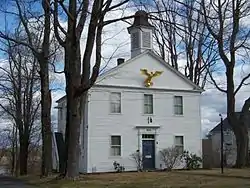Goshen Historic District | |
 Goshen Academy building, in 2010 | |
  | |
| Location | CT 63 and 4, and Gifford Rd., Goshen, Connecticut |
|---|---|
| Coordinates | 41°49′50″N 73°13′25″W / 41.83056°N 73.22361°W |
| Area | 160 acres (65 ha) |
| Built | 1760 |
| Architectural style | Greek Revival, Federal, Victorian |
| NRHP reference No. | 82000996[1] |
| Added to NRHP | December 27, 1982 |
Goshen Historic District is a historic district encompassing the town center village of Goshen, Connecticut.[2] Centered at the junction of Connecticut Routes 4 and 63, the village developed historically as a rural crossroads of two turnpikes, and has retained its rural character. It is dominated by residential architecture from the first half of the 19th century, and includes churches, a store, and the town's former 1895 town hall. It was listed on the National Register of Historic Places in 1982.[1]
Description and history
The town of Goshen, located in the hills of northwestern Connecticut, was settled in the mid-18th century. Its village center, near its geographic center, grew following the development of the east-west turnpike between Torrington and Sharon (now Route 4), and the north-south turnpike between Litchfield and Canaan (now Route 63). The town has remained rural and agricultural in character, with limited industry. In the mid-19th century, the village economy was boosted by the success of Simon Scoville, a blacksmith who established a carriage factory. Scoville's factory has not survived (it was where the town's modern town hall/library/school complex is located, just north of the district), but a remnant iron furnace does survive. Scoville also built a number of modest Greek Revival worker houses.[2]
The historic district extends mainly along Route 63, beginning at Lyman Lane in the south, and ending at the modern town hall complex in the north. It also extends east along Route 4. Historic buildings in the district include examples of Greek Revival, Federal, and Victorian architecture from as early as 1760. Its most prominent buildings are civic and religious in nature, including the Goshen Academy and the 1832 Goshen Congregational Church. The 1895 Old Town Hall, located at the main junction, is a distinctive example of Shingle style architecture. Other examples of Victorian architecture include the Lavallette-Perrin House, which is an eclectic blend of Greek and Gothic Revival elements.[2]
Gallery
 Myron Norton House
Myron Norton House 1832 Congregational Church
1832 Congregational Church Elisha Sill House
Elisha Sill House David Thompson House, guarded by German shepherds
David Thompson House, guarded by German shepherds
See also
References
- 1 2 "National Register Information System". National Register of Historic Places. National Park Service. March 13, 2009.
- 1 2 3 Bruce Clouette and John Herzan (February 26, 1979). "National Register of Historic Places Inventory-Nomination: Goshen Historic District". National Park Service. and Accompanying 22 photos, exteriors and interior, from 1979
External links
- Historic American Buildings Survey (HABS) No. CT-148, "Old Academy, West Goshen, Litchfield County, CT", 1 photo, supplemental material
- Historic American Buildings Survey (HABS) No. CT-147, "Birds Eye Norton House, Goshen, Litchfield County, CT", 5 photos, supplemental material (not confirmed to be within the historic district)
